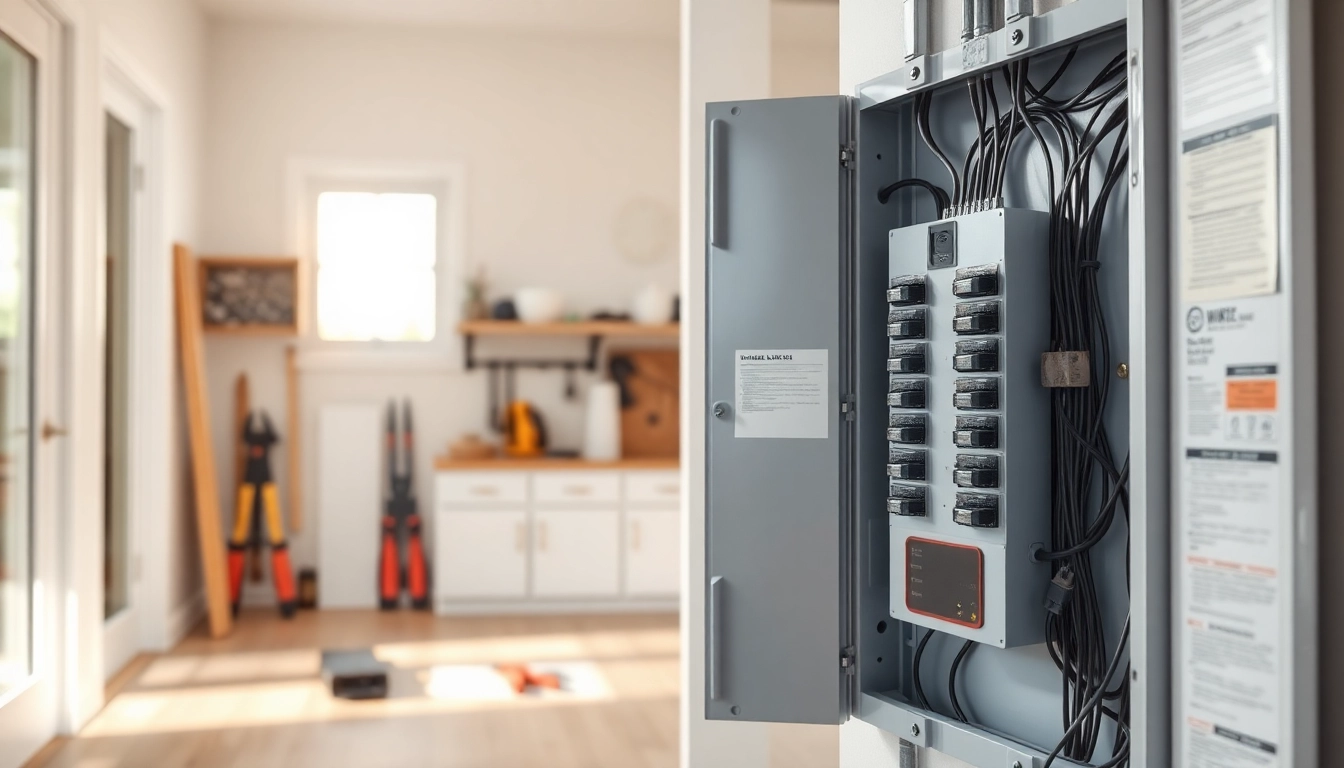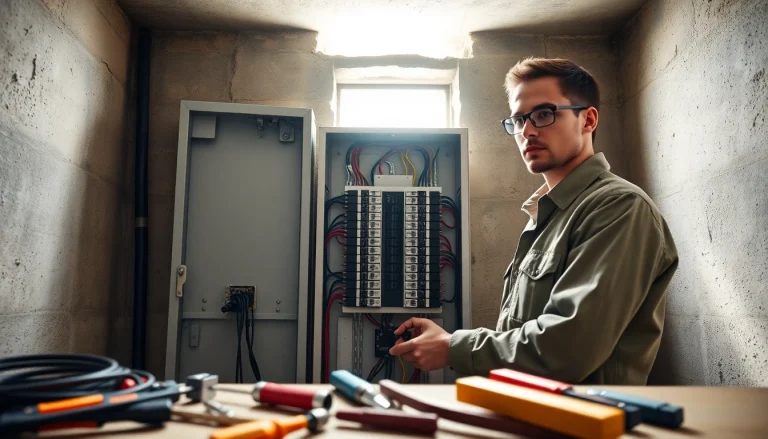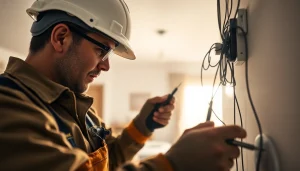What Is an Electrical Panel and Its Function?
Definition of Electrical Panel
An electrical panel, often referred to as a breaker box or service panel, serves as the central hub for the electrical system in your home. It distributes electricity from the utility company into various circuits throughout your home, ensuring that each area has the necessary power for lighting, appliances, and electronic devices. Without a well-functioning electrical panel, the reliable and efficient use of electrical power would be impossible.
Components of an Electrical Panel
Your electrical panel incorporates several key components that collectively ensure the safe distribution and control of electrical power:
- Main Breaker: Acts as the main switch for the entire electrical system, allowing you to shut off power to all circuits when needed.
- Circuit Breakers: Individual switches for each circuit that can trip to prevent overloads and protect wiring from damage.
- Bus Bars: Metal strips that distribute electricity to the circuit breakers.
- Neutral Bar: A component connecting the neutral wires to the grounding system, converting excess current safely.
- Cover or Door: Protects the internal components of the panel and includes safety warnings and labels.
How an Electrical Panel Functions in Your Home
The Electrical Panel functions as the distribution center of an electrical system. Power flows into the panel from the main service line, where it is then directed through the circuit breakers to various circuits in your home. Once power is routed to these circuits, it can be used to power outlets, lights, and appliances, providing the electricity necessary for daily life. In case of a fault or overload, the circuit breakers will trip, cutting off power and preventing potential hazards such as electrical fires.
Signs That Indicate You Need to Upgrade Your Electrical Panel
Outdated Electrical Panel Indicators
Modern electrical systems require an upgraded panel to meet the demand for increased power loads. Here are some signs that indicate your electrical panel may be outdated:
- High Energy Consumption: If your energy bills have been consistently high despite normal usage, it may suggest that your electrical panel cannot efficiently manage your household’s circuits.
- Frequent Circuit Breaker Trips: Regularly tripping circuit breakers indicate that your panel is overloaded and may require an upgrade.
- Age of the Panel: Residential electrical panels should typically be inspected or upgraded every 20 to 30 years. If your home has an older panel, it might no longer meet safety standards.
- Burn Marks or Rust: Physical signs of wear, such as burn marks or rust on the panel, indicate serious underlying issues that require immediate attention.
Common Issues Resulting from Overloaded Panels
An overloaded panel can lead to significant issues, including:
- Electrical Fires: Overloaded circuits can heat wiring beyond its safe limits, posing a danger to your home.
- Equipment Damage: Fluctuating power caused by overloads can damage sensitive electronic devices and appliances.
- Inconsistent Power Supply: Fluctuations in electricity can result in flickering lights or loss of power in certain areas of the home.
Benefits of Upgrading Your Electrical Panel
Upgrading your electrical panel offers several advantages:
- Increased Capacity: A new panel can accommodate additional circuits, allowing for more devices and appliances.
- Enhanced Safety: Modern panels come equipped with better safety features, reducing the risk of electrical fires and equipment damage.
- Improved Energy Efficiency: A well-functioning panel enhances the efficiency of your electrical system, potentially lowering utility bills.
- Compliance with Local Codes: New installations meet updated building codes, ensuring proper safety standards are upheld.
Understanding Electrical Panel Sizes and Specifications
Common Sizes of Electrical Panels
Electrical panels come in various sizes, with common ratings including:
- 100-Amp Panel: Suitable for smaller homes, this size can handle basic electrical needs.
- 150-Amp Panel: A popular choice for average-sized homes with moderate electrical demands.
- 200-Amp Panel: Ideal for larger homes or those with heavy electrical usage, including multiple large appliances.
What Size Do You Need for Your Home?
Determining the appropriate size for your home’s electrical panel depends on various factors:
- Home Size: Larger homes often require a larger panel to handle the higher electrical demand.
- Number of Appliances: The more appliances and devices you use, the higher the capacity needed.
- Future Needs: Consideration for future electrical needs, such as adding new devices or home expansions, is also crucial.
Choosing the Right Specifications for Safety
When upgrading your electrical panel, ensure that you select one that meets local codes and safety standards. Specifications to consider include:
- Quality of Components: Choose panels with high-quality components that can withstand electrical surges.
- Manufacturer Reputation: Select a reputable manufacturer known for reliability and safety.
- Additional Safety Features: Some panels come with advanced safety features such as Ground Fault Circuit Interrupters (GFCIs) and Surge Protective Devices (SPDs).
Maintenance Tips for Your Electrical Panel
Routine Checks and Inspections
Regular maintenance of your electrical panel is essential for ensuring its longevity and safety. Here are some routine checks you can perform:
- Inspect for Damage: Regularly check for any signs of burn marks, rust, or deterioration.
- Test Circuit Breakers: Periodically trip and reset each circuit breaker to ensure they are functioning correctly.
- Keep the Area Clean: Ensure that the area around your panel is free from clutter and debris, allowing for proper ventilation.
Common Maintenance Practices
In addition to routine checks, consider the following maintenance practices:
- Professional Inspections: Schedule regular inspections by a licensed electrician to catch hidden issues early.
- Upgrade Components as Needed: Replace outdated circuit breakers and other components as necessary to enhance safety.
- Keep Documentation Updated: Maintain a record of any work done on the panel and keep your electrical plans up to date.
When to Call a Professional Electrician
While some maintenance tasks can be handled by homeowners, there are times when professional assistance is essential:
- Persistent Issues: If you experience frequent tripping of breakers, it’s time to consult an electrician.
- Panel Upgrades: Any major work involving an upgrade or replacement should be performed by a qualified technician.
- Strange Noises: Unusual sounds like buzzing or crackling from your panel are indications of potential problems that should be examined.
Cost Factors of Upgrading an Electrical Panel
Understanding Installation Costs
The cost of upgrading an electrical panel varies depending on several factors including the size of the panel, the complexity of the installation, and labor costs. Generally, homeowners can expect installation costs ranging from several hundred to a few thousand dollars. Ensuring that you obtain quotes from multiple licensed electricians can provide a more accurate picture of your project’s costs.
Potential Additional Expenses
In addition to installation, other expenses may include:
- Permitting Fees: Local jurisdictions may require permits for electrical work, incurring additional costs.
- Upgrading Wiring: If your home’s existing wiring cannot handle the new panel, you may have to upgrade wiring as well.
- Additional Circuit Installation: Adding new circuits can elevate the total cost of the upgrade.
Budgeting for Your Electrical Panel Upgrade
Budgeting for an electrical panel upgrade should include consideration for all potential costs. Here are steps to create your budget:
- Assess Your Needs: Determine the size and specifications of the panel you will need based on your electrical usage.
- Gather Quotes: Request estimates from several licensed electricians to understand the range of potential costs.
- Plan for Contingencies: Allocate additional funds for unexpected expenses or repairs during the installation process.







